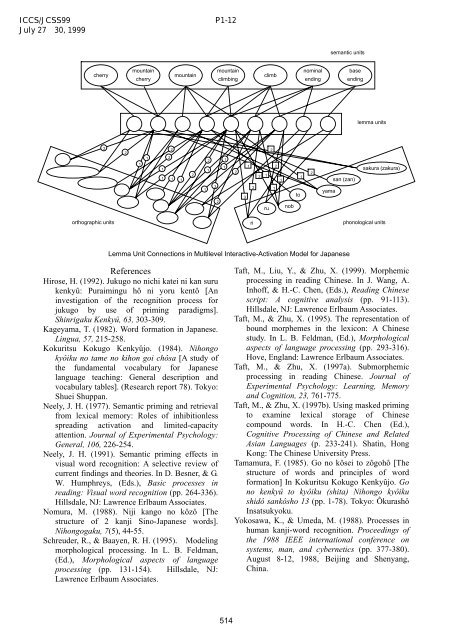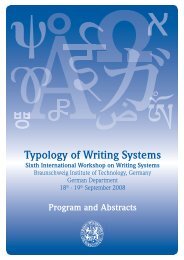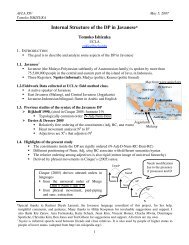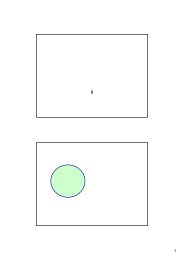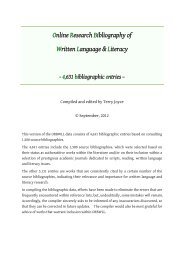A Priming Paradigm Study Terry Joyce, University of Tsukuba
A Priming Paradigm Study Terry Joyce, University of Tsukuba
A Priming Paradigm Study Terry Joyce, University of Tsukuba
You also want an ePaper? Increase the reach of your titles
YUMPU automatically turns print PDFs into web optimized ePapers that Google loves.
ICCS/JCSS99 P1-12<br />
July 2730, 1999<br />
semantic units<br />
cherry<br />
mountain<br />
cherry<br />
mountain<br />
mountain<br />
climbing<br />
climb<br />
nominal<br />
ending<br />
base<br />
ending<br />
lemma units<br />
<br />
<br />
<br />
2<br />
<br />
2<br />
<br />
1<br />
1<br />
<br />
<br />
2<br />
2<br />
1<br />
1 1 1<br />
2<br />
<br />
2<br />
1<br />
1<br />
3<br />
2<br />
1<br />
1<br />
2<br />
1<br />
2<br />
3<br />
2<br />
2<br />
2<br />
1<br />
1<br />
1<br />
1<br />
to<br />
ru<br />
nob<br />
2<br />
san (zan)<br />
yama<br />
sakura (zakura)<br />
orthographic units<br />
<br />
<br />
ri<br />
phonological units<br />
Lemma Unit Connections in Multilevel Interactive-Activation Model for Japanese<br />
References<br />
Hirose, H. (1992). Jukugo no nichi katei ni kan suru<br />
kenkyû: Puraimingu hô ni yoru kentô [An<br />
investigation <strong>of</strong> the recognition process for<br />
jukugo by use <strong>of</strong> priming paradigms].<br />
Shinrigaku Kenkyû, 63, 303-309.<br />
Kageyama, T. (1982). Word formation in Japanese.<br />
Lingua, 57, 215-258.<br />
Kokuritsu Kokugo Kenkyûjo. (1984). Nihongo<br />
kyôiku no tame no kihon goi chôsa [A study <strong>of</strong><br />
the fundamental vocabulary for Japanese<br />
language teaching: General description and<br />
vocabulary tables]. (Research report 78). Tokyo:<br />
Shuei Shuppan.<br />
Neely, J. H. (1977). Semantic priming and retrieval<br />
from lexical memory: Roles <strong>of</strong> inhibitionless<br />
spreading activation and limited-capacity<br />
attention. Journal <strong>of</strong> Experimental Psychology:<br />
General, 106, 226-254.<br />
Neely, J. H. (1991). Semantic priming effects in<br />
visual word recognition: A selective review <strong>of</strong><br />
current findings and theories. In D. Besner, & G.<br />
W. Humphreys, (Eds.), Basic processes in<br />
reading: Visual word recognition (pp. 264-336).<br />
Hillsdale, NJ: Lawrence Erlbaum Associates.<br />
Nomura, M. (1988). Niji kango no kôzô [The<br />
structure <strong>of</strong> 2 kanji Sino-Japanese words].<br />
Nihongogaku, 7(5), 44-55.<br />
Schreuder, R., & Baayen, R. H. (1995). Modeling<br />
morphological processing. In L. B. Feldman,<br />
(Ed.), Morphological aspects <strong>of</strong> language<br />
processing (pp. 131-154). Hillsdale, NJ:<br />
Lawrence Erlbaum Associates.<br />
Taft, M., Liu, Y., & Zhu, X. (1999). Morphemic<br />
processing in reading Chinese. In J. Wang, A.<br />
Inh<strong>of</strong>f, & H.-C. Chen, (Eds.), Reading Chinese<br />
script: A cognitive analysis (pp. 91-113).<br />
Hillsdale, NJ: Lawrence Erlbaum Associates.<br />
Taft, M., & Zhu, X. (1995). The representation <strong>of</strong><br />
bound morphemes in the lexicon: A Chinese<br />
study. In L. B. Feldman, (Ed.), Morphological<br />
aspects <strong>of</strong> language processing (pp. 293-316).<br />
Hove, England: Lawrence Erlbaum Associates.<br />
Taft, M., & Zhu, X. (1997a). Submorphemic<br />
processing in reading Chinese. Journal <strong>of</strong><br />
Experimental Psychology: Learning, Memory<br />
and Cognition, 23, 761-775.<br />
Taft, M., & Zhu, X. (1997b). Using masked priming<br />
to examine lexical storage <strong>of</strong> Chinese<br />
compound words. In H.-C. Chen (Ed.),<br />
Cognitive Processing <strong>of</strong> Chinese and Related<br />
Asian Languages (p. 233-241). Shatin, Hong<br />
Kong: The Chinese <strong>University</strong> Press.<br />
Tamamura, F. (1985). Go no kôsei to zôgohô [The<br />
structure <strong>of</strong> words and principles <strong>of</strong> word<br />
formation] In Kokuritsu Kokugo Kenkyûjo. Go<br />
no kenkyû to kyôiku (shita) Nihongo kyôiku<br />
shidô sankôsho 13 (pp. 1-78). Tokyo: Ôkurashô<br />
Insatsukyoku.<br />
Yokosawa, K., & Umeda, M. (1988). Processes in<br />
human kanji-word recognition. Proceedings <strong>of</strong><br />
the 1988 IEEE international conference on<br />
systems, man, and cybernetics (pp. 377-380).<br />
August 8-12, 1988, Beijing and Shenyang,<br />
China.<br />
514


